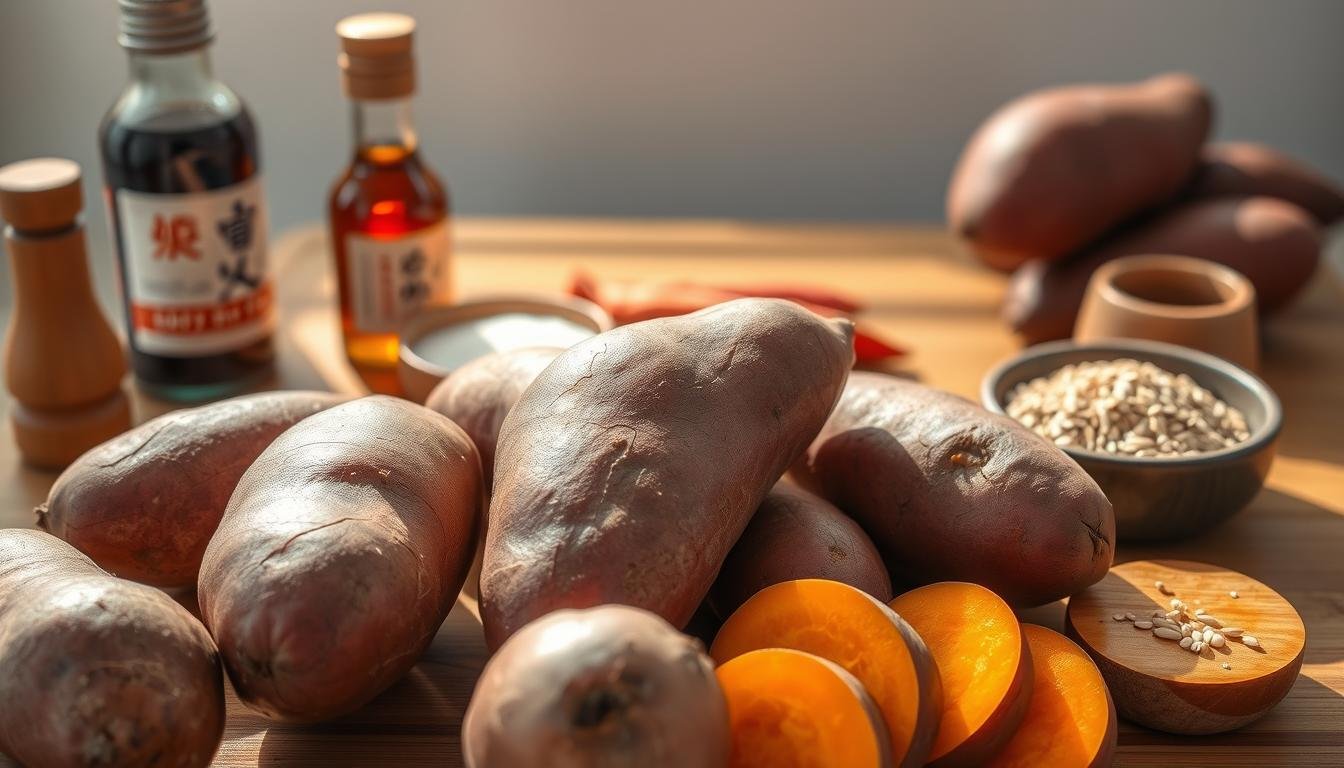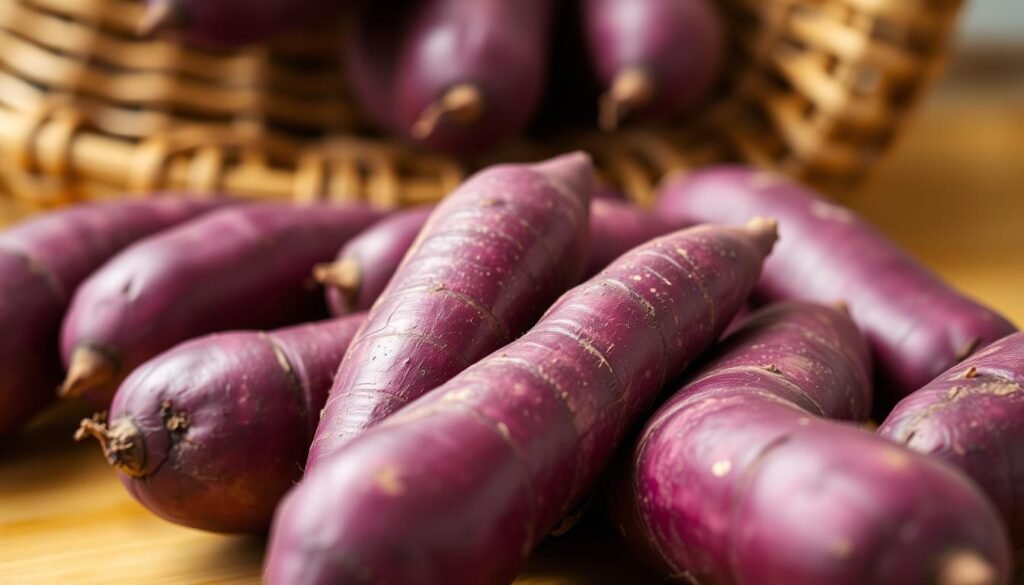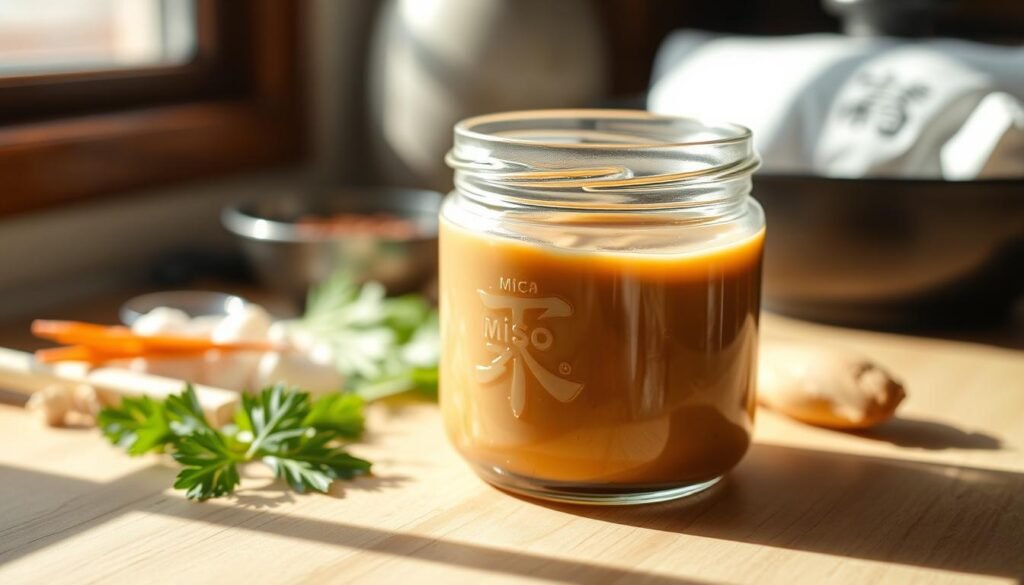5 Essential Ingredients for Authentic Japanese Sweet Potato Dishes

Walk into your kitchen. Smell the roasted sweet potatoes mixing with the rich smell of miso paste. How lovely! The first time I tried making traditional Japanese sweet potato dishes, I was so excited. Using real Japanese sweet potato ingredients makes a meal taste amazing and full of history.
I learned a lot about Japanese cooking. Every ingredient has its own story. Take Murasaki sweet potatoes, for instance. They have deep purple skins and a sweet, nutty taste. Add in things like miso paste and sesame seeds. These ingredients make Japanese sweet potato dishes really special. They fill every bite with tradition and comfort.
It’s time to step up your cooking! Here are five must-have ingredients for real Japanese sweet potato dishes. They’ll make your kitchen smell like a warm Japanese home. And your taste buds will thank you with every bite.
Key Takeaways
- Explore the rich, earthy flavors of Murasaki sweet potatoes.
- Enhance your dishes with the umami touch of miso paste.
- Add texture and taste with toasted sesame seeds.
- Incorporate traditional ingredients to ensure authenticity.
- Experience Japanese culinary traditions right in your own kitchen.
The Rich History of Japanese Sweet Potatoes
Japanese sweet potatoes have a long history, starting in the Edo period. Brought to Japan in the 17th century, they quickly became important. This was due to their ability to adapt and their health benefits. The way they’re grown, traditional cultivation practices, makes them special.
Farmers have passed down their growing methods for generations. This shows the strong bond between farmers and their land. These methods help keep the potatoes high-quality. They also protect the variety of the potato, making it a good choice for the environment.
These potatoes are more than just food in Japan. They are a big part of Japan’s cultural traditions and holiday meals. They stand for wealth and health. Because of this history and how useful they are in cooking, they’re key to Japanese food.
Types of Authentic Japanese Sweet Potatoes
When looking at Japanese sweet potatoes, the Murasaki is a top choice. It has purple skin, a white inside, and a nuttier taste. The Annou sweet potato is another favorite, offering a creamy texture and a hint of caramel. Then there’s the eye-catching Beni Imo. Its purple inside really pops on the plate!

The Murasaki is great for baking because of its firm texture. The Annou variety is a dessert dream, thanks to its sweetness. The Beni Imo is a star in traditional dishes because of its color and texture. Trying these types will make your meals more exciting, no matter if you’re new to Japanese food or an expert cook!
Here’s a quick comparison of these varieties:
| Variety | Skin Color | Flesh Color | Flavor Profile |
|---|---|---|---|
| Murasaki | Purple | White | Nuttier |
| Annou | Orange | Yellow | Creamy & Sweet |
| Beni Imo | Dark Purple | Bright Purple | Slightly Sweet |
Key Flavor Components in Sweet Potato Dishes
If you’ve ever savored a Japanese sweet potato dish, you know its *sweetness and texture* are delightful! But what really makes these dishes special is the mix of flavors. This includes the sweetness, hearty texture, and the umami depth.
The natural *sweetness and texture* of Japanese sweet potatoes get even better with soybeans and miso paste. This combo brings a deep umami taste. Imagine eating a soft, sweet sweet potato. Each bite reveals more tasty complexity!
Think of it this way—sweet potatoes alone are tasty, but mixing them with soy sauce or kombu (kelp) makes them even better. Soy sauce adds a savory saltiness. Kombu gives a touch of umami, which is essential in many sweet potato dishes.
Looking for an example? Try miso-glazed sweet potato. The miso paste boosts the *sweetness and texture* of the sweet potato and gives a rich umami flavor. It’s perfect for a cozy meal!
| Component | Effect on Flavor |
|---|---|
| Sweetness | Enhances natural sweetness, providing a delightful primary taste. |
| Texture | Offers a hearty, comforting bite that’s both soft and rich. |
| Umami Enhancements (Soybeans, Miso) | Amplifies depth and complexity, making the dish incredibly satisfying. |
Don’t just take my word for it—try it out yourself! Balancing these flavors can change everything. Enjoy the process of discovery, and happy cooking!

Cooking Methods for Sweet Potatoes
There are many great ways to cook Japanese sweet potatoes. Each method brings out different flavors and textures. Choose from steaming, roasting, or boiling to make a tasty dish!

Steaming is a top method for these sweet potatoes. It keeps their sweet taste and soft texture. Just steam them for 30-40 minutes for perfect results.
Roasting makes the potatoes sweet and crispy. Heat your oven to 400°F (200°C) and bake them on a sheet for 45-60 minutes. They get a golden finish that’s hard to beat.
Boiling is a simple method. Just boil the sweet potatoes for 20-30 minutes. They become tender and keep their natural sweetness. This method is great for mashing or soups.
Here’s a quick comparison of these cooking methods:
| Method | Texture | Flavor | Duration |
|---|---|---|---|
| Steaming | Soft and moist | Delicate and sweet | 30-40 minutes |
| Roasting | Crispy exterior, creamy inside | Caramelized sweetness | 45-60 minutes |
| Boiling | Soft | Natural sweetness | 20-30 minutes |
Try these methods to find the best way to cook Japanese sweet potatoes. Next time, maybe steam or roast them for an even better taste!
Essential Ingredients to Pair with Japanese Sweet Potatoes
To improve Japanese sweet potatoes, some ingredients are key. Miso paste is top on my list. It has a rich taste that matches the potatoes’ sweetness. Ever tasted it?
Don’t forget sesame seeds on top. They give a fun crunch and a nutty taste. They’re perfect with sweet potatoes.

Daizu, or soybeans, are also great. They bring nutrition and protein. They also make the dish more interesting in texture.
Here’s a table to quickly show you these awesome food combos:
| Ingredient | Flavor Profile | Benefits | Use in Recipes |
|---|---|---|---|
| Miso Paste | Umami, Salty | Rich in Probiotics, Adds Depth | Soups, Sauces, Glazes |
| Sesame Seeds | Nutty, Crunchy | Rich in Healthy Fats, Adds Texture | Garnish, Roasting |
| Daizu (Soybeans) | Nutty, Firm | High in Protein, Adds Texture | Salads, Stir-Fries |
Miso paste, sesame seeds, and daizu boost flavor and health. Try them out. They’ll make your dishes special!
Preparing Japanese Sweet Potato Dishes
Mastering the art of making Japanese sweet potato dishes is a total game-changer! First, you’ve got to nail the wash and peel techniques. A well-cleaned and peeled sweet potato is key. I start by scrubbing them under cold water to remove all dirt.
After they’re clean, peeling is next. I love using a sharp peeler for a smooth peel. But, keeping some skin on can add texture and taste. Then, when slicing, aim for evenness. I cut them into rounds or cubes for uniform cooking.

Want a tip for extra flavor? After cleaning and peeling, soak the slices for 30 minutes. It pulls out excess starch, making them creamy and tender after cooking. So, always remember these wash and peel techniques for top-notch Japanese sweet potato dishes!
| Preparatory Step | Details |
|---|---|
| Washing | Scrub under cold water to remove dirt |
| Peeling | Use a sharp peeler for a smooth finish |
| Slicing | Cut into uniform pieces for even cooking |
| Soaking | Soak slices for 30 minutes to remove excess starch |
Popular Japanese Sweet Potato Recipes
Let’s dive into some yummy Japanese sweet potato recipes. They are tasteful and fun to cook! Yaki Imo or Baked Sweet Potatoes, is a top pick. It is easy to make and very tasty. Bake the sweet potatoes, and you’re set with a cozy sweet snack for any time.

Don’t miss trying Sweet Potato Tempura. It’s a crispy and light treat. This dish takes slices of sweet potato, dips them in batter, and fries them. You end up with a wonderful mix of crunch and sweet.
Yaki Imo and Sweet Potato Tempura really show how flexible Japanese sweet potatoes can be. These recipes are great whether you’re just starting or are already a fan. They’re bound to be loved by your family!
| Recipe Name | Main Ingredient | Cooking Method |
|---|---|---|
| Yaki Imo (Baked Sweet Potatoes) | Sweet Potatoes | Baking |
| Sweet Potato Tempura | Sweet Potatoes | Frying |
Are you ready to try these yummy dishes? I can’t wait to see how much you enjoy them! 🥔✨
Nutritional Benefits of Japanese Sweet Potatoes
Japanese sweet potatoes taste amazing and are healthy too! They have lots of vitamins and minerals. They are perfect for any diet.

So, what makes these sweet potatoes unique? They have a lot of dietary fiber which is good for your tummy. It makes you feel full. They’re packed with Vitamin A and C too, which help your immune system and skin.
Here’s a quick look at their nutritional content:
| Nutrient | Amount per 100g |
|---|---|
| Calories | 86 |
| Vitamin A | 709 µg |
| Vitamin C | 2.4 mg |
| Fiber | 3 g |
| Potassium | 337 mg |
Why are they great for health? They’re loaded with potassium. This controls blood pressure and manages body fluids. Their taste plus nutrients make them a great choice for your diet!
Where to Buy Authentic Japanese Sweet Potatoes
Looking for authentic Japanese sweet potatoes is exciting! Start at Local Asian Markets. These places often get fresh veggies straight from the best sources. Here, you can find lots of sweet potatoes for your cooking.

Don’t want to go out? Online stores are great too. Sites like Mitsuwa Marketplace and Yamibuy focus on Japanese goods. It’s easy to check prices and reviews to find the best sweet potatoes.
Here’s a guide on where to find Japanese sweet potatoes:
| Source | Advantages | Disadvantages |
|---|---|---|
| Local Asian Markets | Fresh produce, immediate availability | Limited stock, might have to travel |
| Online Specialty Stores | Convenient, more choices | Extra shipping cost, might wait longer |
So, whether you visit Local Asian Markets or buy online, make sure it’s from a trusted place. Enjoy your cooking!
Tips for Storing Sweet Potatoes
Storing your Japanese sweet potatoes right is crucial. You need good storage to keep them fresh. Aim to create the perfect conditions for them. This way, they stay fresh until you’re ready to cook.
Don’t put your sweet potatoes in the fridge. It changes their texture and taste. Instead, keep them in a cool, dark spot. A pantry, cellar, or cupboard works great. It keeps them sweet and full of nutrients.
Keep an eye on the humidity too. Too much moisture leads to mold. Too little, and they’ll dry out. Try to keep humidity around 60%-70%. Use a bag with holes or a container that’s not fully covered. This helps avoid mold.
Wondering how long they last? If stored right, they stay fresh for a month or more. So, you can buy extra sweet potatoes without worry. Enjoy their great taste for a longer time.